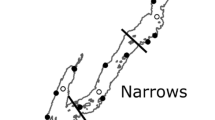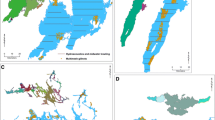Abstract
One goal of regional-scale sample surveys is to estimate the status of a resource of interest from a statistically drawn representative sample of that resource. An expression of status is the frequency distribution of indicator scores capturing variability of attributesof interest. However, extraneous variability interferes with the status description by introducing bias into the frequency distributions. To examine this issue, we used data from a regional survey of lakes in the Northeast U.S. collected by the U.S. Environmental Protection Agency's Environmental Monitoring and Assessment Program (EMAP). We employ a components of variance model to identify sources of extraneous variance pertinent to status descriptions of physical, chemical, and biological attributes of the population of lakes in the NE. We summarize the relative magnitude of four components of variance (lake-to-lake, year, interaction, and residual) for each indicator and illustrate how extraneous variance biases the status descriptions. We describe a procedure that removes this bias from the status descriptions to produce unbiased estimates and introduce a novel method for estimating the `cost' of removing the bias (expressed as either increased sampling uncertainty or additionalsamples needed to achieve the target precision in the absence of bias). We compare the relative magnitude of the four variance components across the array of indicators, finding in general that conservative chemical indicators are least affected by extraneous variance, followed by some nonconservative indicators, with nutrient indicators most affected by extraneous variance. Intermediate were trophic condition indicators (including sediment diatoms), fish species richness and individuals indicators, and zooplankton taxa richness and individuals indicators.We found no clear patterns in the relative magnitude of variance components as a function of several methods of aggregating fish and zooplankton indicators (e.g., level of taxonomy, or speciesrichness vs. numbers of individuals).
Similar content being viewed by others
References
Baker, J. R., Peck, D. V. and Sutton, D. W. (eds.): 1997, Environmental Monitoring and Assessment Program–Surface Waters: Field Operations Manual for Lakes, EPA/620/R-97/001, U.S. Environmental Protection Agency, Washington, D.C.
Carlson, R. E.: 1977: ‘A trophic state index for lakes’, Limnol. Oceanogr. 22, 363–369.
Cumming, B. F., Smol, J. P., Kingston, J. C., Charles, D. F., Birks, H. J. B., Camburn, K. E., Dixit, S. S., Uutala, A. J. and Selle, A. R.: 1992, ‘How much acidification has occurred in the Adirondack region (New York, U.S.A.) lakes since pre-industrial times?’, Can. J. Fish. Aquat. Sci. 49, 129–141.
Dixit, S. S., Smol, J. P., Charles, D. F., Hughes, R. M., Paulsen, S. G. and Collins, G. B.: 1999, ‘Assessing water quality changes in the lakes of the northeastern United States using sediment diatoms’, Can. J. Fish. Aquat. Sci. 56, 131–152.
Frost, T. M., Carpenter, S. R. and Kratz, T. K.: 1992, ‘Choosing Ecological Indicators: Effects of Taxonomic Aggregation on Sensitivity to Stress and Natural Variability’, in: D. H. McKenzie, D. E. Hyatt and V. J. McDonald (eds), Ecological Indicators, Elsevier Applied Science, New York, pp. 215–227.
Gaffy, W.: 1959, ‘A consistent estimator of a component of a convolution’, Ann. Math. Stat. 30, 198–205.
Horne, A. J. and Goldman, C. R.: 1994, Limnology, 2nd ed., McGraw-Hill, New York.
Klang, J. L. K.: 1997, Citizen Lake-Monitoring Program: 1996 Report on the Transparency of Minnesota Lakes, Minnesota Pollution Control Agency, Division of Water Quality, St. Paul, Minnesota.
Kratz, T. K., Magnuson, J. J., Frost, T. M., Benson, B. J. and Carpenter, S. R.: 1994, ‘Landscape Position, Scaling, and the Spatial and Temporal Variability of Ecological Parameters: Considerations for Biological Monitoring’, in: S. L. Loeb and A. Spacie (eds), Biological Monitoring of Aquatic Ecosystems, Lewis Publishers, Boca Raton, Florida, pp. 217–231.
Kratz, T. K., Magnuson, J. J., Bayley, P., Benson, B. J., Berish, C. W., Bledsoe, C. S., Blood, E. R., Bowser, C. J., Carpenter, S. R., Cunningham, G. L., Dahlgren, R. A., Frost, T. M., Halfpenny, J. C., Hansen, J. D., Heisey, D., Inouye, R. S., Kaufman, D. W., McKee, A. and Yarie, J.: 1995, ‘Temporal and Spatial Variability as Neglected Ecosystem Properties: Lessons Learned from 12 American Ecosysems’, in: D. Rapport and P. Calow (eds), Evaluating and Monitoring the Health of Large-Scale Ecosystems, Springer-Verlag, New York, pp. 359–383.
Larsen, D. P., Thornton, K.W., Urquhart, N. S. and Paulsen, S. G.: 1994, ‘The role of sample surveys for monitoring the condition of the nation’s lakes’, Environ. Monit. Assess. 32, 101–134.
Larsen, D. P., Urquhart. N. S. and Kugler, D. L.: 1995, ‘Regional scale trend monitoring of indicators of tropic conditions of lakes’, Water Resour. Bull. 31, 117–140.
Larsen, D. P., Kincaid, T. M., Jacobs, S. E. and Urquhart, N. S.: 2001, ‘Designs for evaluating local and regional scale trends’, BioScience 51, 1069–1078.
Lee, J., Binkley, M. R. and Carlson, R. E.: 1997, ‘The great American Secchi dip-In’, GIS World 10, 42–44.
Lewis Jr., W. M.: 1978, ‘Comparison of temporal and spatial variation in the zooplankton of a lake by means of variance components’, Ecology 59, 666–671.
Matthews, W. J.: 1990, ‘Spatial and temporal variation in fishes of riffle habitats: A comparison of analytical approaches for the Roanoke River’, Am. Midl. Nat. 124, 31–45.
Messer, J. J., Linthurst, R. A. and Overton, W. S.: 1991, ‘An EPA program for monitoring ecological status and trends’, Environ. Monit. Assess. 17, 67–78.
Olsen, A. R., Sedransk, J., Edwards, D., Gotway, C. A., Liggett, W., Rathbun, S., Reckhow, K. H. and Young, L. J.: 1999, ‘Statistical issues for monitoring ecological and natural resources in the United States’, Environ. Monit. Assess. 54, 1–45.
Overton, W. S.: 1989, ‘Effects of Measurement and Other Extraneous Errors on Estimated Distribution Functions in the National Surface Water Surveys’, Technical Report 129, Department of Statistics, Oregon State University, Corvallis, Oregon.
Overton, W. S., White, D. and Stevens, D. L.: 1991, Design Report for EMAP, the Environmental Monitoring and Assessment Program, EPA/600/3-91/053, U.S. Environmental Protection Agency, Washington, D.C.
Searle, S. R.: 1971, Linear Models, John Wiley & Sons, New York.
Searle, S. R., Casella, G. and McCulloch, C. E.: 1992, Variance Components, John Wiley & Sons, New York.
Stemberger, R. S., Larsen, D. P. and Kincaid, T. M.: 2001, ‘Sensitivity of zooplankton for regional lake monitoring’, Can. J. Fish. Aquat. Sci. 58, 2222–2232.
Stevens, D. L.: 1994, ‘Implementation of a national monitoring program’, J. Environ. Manage. 42, 1–29.
Urquhart, N. S., Paulsen, S. G. and Larsen, D. L.: 1998, ‘Monitoring for policy-relevant regional trends over time’, Ecol. Appl. 8, 246–257.
Urquhart, N. S. and Kincaid, T. M.: 1999, ‘Designs for detecting trend from repeated surveys of ecological resources’, J. Agric. Biol. Envir. S. 4, 404–414.
Vaux, P. D., Whittier, T. R., DeCeasre, G. and Kurtenbach, J. P.: 2000, ‘Evaluation of a backpack electrofishing unit for multiple lake surveys of fish assemblage structure’, N. Am. J. Fish. Manage. 20, 168–179.
Wetzel, R. G.: 2001, Limnology: Lake and River Ecosystems, 3rd ed., Academic Press, New York.
Author information
Authors and Affiliations
Corresponding author
Rights and permissions
About this article
Cite this article
Kincaid, T.M., Larsen, D.P. & Scott Urquhart, N. The Structure of Variation and Its Influence on the Estimation of Status: Indicators of Condition of Lakes in the Northeast, U.S.A.. Environ Monit Assess 98, 1–21 (2004). https://doi.org/10.1023/B:EMAS.0000038176.68766.71
Issue Date:
DOI: https://doi.org/10.1023/B:EMAS.0000038176.68766.71




